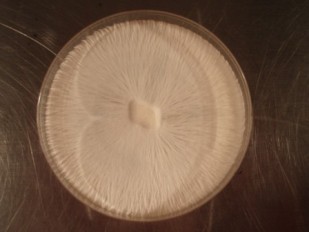
Growing and expanding spawn
 So you've cloned
your mushroom ---
now what? Paul Stamet's Growing
Gourmet and Medicinal Mushrooms
comes at this from a commercial point of view, so he recommends working
in an
ultra-sterile laboratory and growing cloned mushrooms on agar in
petri dishes. Once the mycelium has nearly colonized the entire
petri dish, he cuts the agar into sections and uses it to inoculate
jars of grain.
So you've cloned
your mushroom ---
now what? Paul Stamet's Growing
Gourmet and Medicinal Mushrooms
comes at this from a commercial point of view, so he recommends working
in an
ultra-sterile laboratory and growing cloned mushrooms on agar in
petri dishes. Once the mycelium has nearly colonized the entire
petri dish, he cuts the agar into sections and uses it to inoculate
jars of grain.
Although Stamets' lab
technique isn't really applicable on our farm, I
still teased out a lot of information that will probably be equally
true for our cardboard
mushroom cultivation.
The purpose of this stage in the procedure --- known as the spawn run
--- is to take a little bit of fungal growth and turn it into a lot of
growth. Stamets repeatedly urges you to keep the spawn running at
all times by providing the perfect growing conditions --- moderate
humidity of around 60 to 75%, a warm temperature
around 75 degrees Fahrenheit, and darkness to moderate light.
If you play your cards
right, the mycelium will run very quickly at this point and it must
always have more room to grow into. Never let the spawn cover all
of its petri
dish/ cardboard/ whatever or it will use up its food, build up wastes
to
toxic levels, and lose vitality. Once the mycelium comes near the
edge of its container, expand it by mixing the spawn into five to ten
times as much fresh substrate. Feel free to expand your spawn
twice (which means it can become 100 times bigger than it was to start
with!), but use caution when expanding beyond that or your mycelium may
show loss of vigor.
This post is part of our Growing Gourmet Mushrooms lunchtime series.
Read all of the entries:
|
Want more in-depth information? Browse through our books.
Or explore more posts by date or by subject.
About us: Anna Hess and Mark Hamilton spent over a decade living self-sufficiently in the mountains of Virginia before moving north to start over from scratch in the foothills of Ohio. They've experimented with permaculture, no-till gardening, trailersteading, home-based microbusinesses and much more, writing about their adventures in both blogs and books.
Want to be notified when new comments are posted on this page? Click on the RSS button after you add a comment to subscribe to the comment feed, or simply check the box beside "email replies to me" while writing your comment.

We keep our mushrooms under the shade of our trees --- we've got plenty of trees, and filtered light is actually good for them.
That said, we'd love to get shipping containers as easy house bases. Unfortunately, it's not really realistic to get them back to our living area --- it's a half mile walk across a creek and through lots of mud. It took a bulldozer to get our trailer back here. But maybe that would be a good cheap storage unit where we park our cars (and where stuff tends to accumulate until we get around to carrying it home.) Great idea!
Cultivating fungus is far easier than accessing data here: Looking for page about exogenous products produced by contaminants that are responsible for challenging altered states.